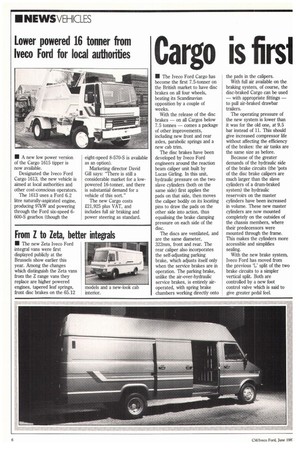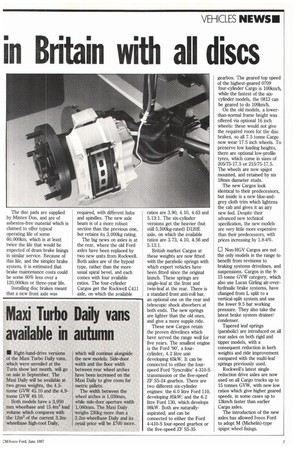Cargo is firsl in Britain with all discs
Page 92

Page 93

If you've noticed an error in this article please click here to report it so we can fix it.
• The Iveco Ford Cargo has become the first 7.5-tonner on the British market to have disc brakes on all four wheels, beating its Scandinavian opposition by a couple of weeks.
With the release of the disc brakes — on all Cargos below 7.5 tonnes — comes a package of other improvements, including new front and rear axles, parabolic springs and a new cab trim.
The disc brakes have been developed by Iveco Ford engineers around the reaction beam caliper unit built by Lucas Girling. In this unit, hydraulic pressure on the two slave cylinders (both on the same side) first applies the pads on that side, then moves the caliper bodily on its locating pins to draw the pads on the other side into action, thus equalising the brake clamping pressure on each side of the disc.
The discs are ventilated, and are the same diameter, 322mm, front and rear. The rear caliper also incorporates the self-adjusting parking brake, which adjusts itself only when the service brakes are in operation. The parking brake, unlike the air-over-hydraulic service brakes, is entirely airoperated, with spring brake chambers working directly onto the pads in the calipers.
With full air available on the braking system, of course, the disc-braked Cargo can be used — with appropriate fittings — to pull air-braked drawbar trailers.
The operating pressure of the new system is lower than it was for the old one, at 9.5 bar instead of 11. This should ,give increased compressor life without affecting the efficiency of the brakes: the air tanks are the same size as before.
Because of the greater demands of the hydraulic side of the brake circuits (the 'pots of the disc brake calipers are much larger than the slave cylinders of a drum-braked system) the hydraulic reservoirs on the master cylinders have been increased in volume. These new master cylinders are now mounted completely on the outsides of the chassis members, where their predecessors were mounted through the frame. This makes the cylinders more accessible and simplifies sealing.
With the new brake system, Iveco Ford has moved from the previous 1' split of the two brake circuits to a simpler vertical split. Both are controlled by a new foot control valve which is said to give greater pedal feel. The disc pads are supplied by Nlintex Don, and are of asbestos-free material which is claimed to offer typical operating life of some 60,000km, which is at least twice the life that would be expected of drum brake linings in similar service. Because of this life, and the simpler brake system, it is estimated that brake maintenance costs could be some 60% less over a 120,000km or three-year life.
Installing disc brakes meant that a new front axle was required, with different hubs and spindles. The new axle beam is of a more robust section than the previous one, but retains its 3,000kg rating.
The big news on axles is at the rear, where the old Ford axles have been replaced by two new units from Rockwell. Both axles are of the hypoid type, rather than the more usual spiral bevel, and each comes with four available ratios. The four-cylinder Cargos get the Rockwell C411 axle, on which the available ratios are 3.90, 4.10, 4.63 and 5.13:1. The six-cylinder versions get the heavier (but still 5,500kg-rated) D120E axle, on which the available ratios are 3.73, 4.10, 4.56 and 5.13:1.
British market Cargos at these weights are now fitted with the parabolic springs with which export vehicles have been fitted since the original launch. These springs are single-leaf at the front and twin-leaf at the rear. There is a standard front anti-roll bar, an optional one on the rear and telescopic shock absorbers at both ends. The new springs are lighter than the old ones, and give a more supple ride.
These new Cargos retain the proven drivelines which have served the range well for five years. The smallest engine is the Ford '90', a fourcylinder, 4.2 litre unit developing 65kW. It can be connected to either the fourspeed Ford 'Syncrolite' 4-310-S transmission or the five-speed ZF 55-24 gearbox. There are two different six-cylinder engines: the 6.0 litre Ford 110, developing 85kW; and the 6.2 litre Ford 130, which develops 98kW. Both are naturallyaspirated, and can be connected to either the Ford 4-410-S four-speed gearbox or the five-speed ZF S5-35 gearbox. The geared top speed of the highest-geared 0709 four-cylinder Cargo is 100krn/h, while the fastest of the sixcylinder models, the 0813 can be geared to do 109km/h.
On the old models, a lowerthan-normal frame height was offered via optional 16 inch wheels: these would not give the required room for the disc brakes, so all 7.5 tonne Cargo now wear 17.5 inch wheels. To preserve low loading heights, there are optional low-profile tyres, which come in sizes of 205/75-17.5 or 215/75-17.5. The wheels are now spigot mounted, and retained by six 18mm diameter studs.
The new Cargos look identical to their predecessors, but inside is a new blue-andgrey cloth trim which lightens the cab and gives it an airy new feeL Despite their advanced new technical specification, the new models are very little more expensive than their predecessors, with prices increasing by 1.8-4%.
Non-HGV Cargos are not the only models in the range to benefit from revisions to braking systems drivelines, and suspensions. Cargos in the 915 tonne GVW category, which also use Lucas Girling air-overhydraulic brake systems, have changed from L split to a vertical-split system and use the lower 9.5 bar working pressure. They also take the latest brake system drainer/ condenser.
Tapered leaf springs (parabolic) are introduced on all rear axles on both rigid and tipper models, with a consequent reduction in kerb weights and ride improvement compared with the multi-leaf springs previously used.
Rockwell's latest single reduction drive axles are now used on all Cargo trucks up to 15 tonnes GVW, with new low ratios which give higher geared speeds, in some cases up to 131cm/h faster than earlier Cargo axles.
The introduction of the new axles has allowed Iveco Ford to adopt M (Michelin)-type spigot wheel fixings.
























































































































